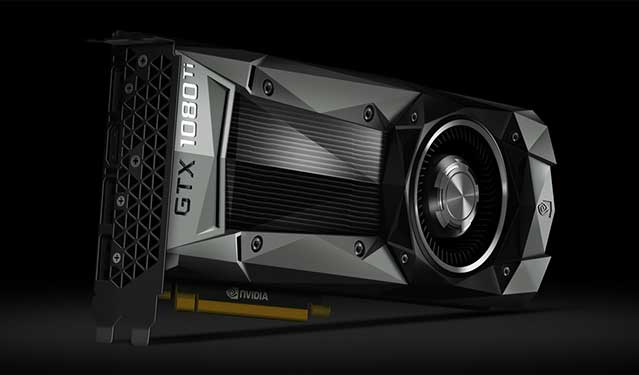When Nvidia released the GTX 1080 Ti ahead of an (at the time) perceived threat at the top-end from AMD’s incoming Vega cards, it broke the mould. Not only did it offer performance far in excess of what the previous top-tier Nvidia 1080 card could offer, but it did so so emphatically, that even three years on from its debut, it’s still one of the best graphics cards in the world.
Nvidia has since moved on to newer, bigger, and better things, but not by as much as you might think. The RTX Turing generation of graphics cards has its own top-tier Ti card, the 2080 Ti, and it’s by far the most powerful graphics card gamers can buy. But go one notch down the spectrum and the 2080 still faces competition from not only new cards like the Nvidia RTX 2070 Super, but the last-generation 1080 Ti as well.
That’s what makes this graphical matchup so compelling, especially when you factor in the low-cost of second-hand components.
 “Nvidia@16nm@Pascal@GP102@GeForce_GTX_1080_Ti@A_TAIWAN_1653A1_PBFV81.C00_GP102-350-K1-A1___DSC05050” by FritzchensFritz is licensed under CC0 1.0
“Nvidia@16nm@Pascal@GP102@GeForce_GTX_1080_Ti@A_TAIWAN_1653A1_PBFV81.C00_GP102-350-K1-A1___DSC05050” by FritzchensFritz is licensed under CC0 1.0 Raw power
While noise output, energy usage, and looks factor into a graphics card’s appeal, it is performance that is arguably the most important factor. How much raw power do you actually get for your money?
In this match up, both cards are within a few percent points of each other in most modern games. However, there are a few particulars worth considering. Very modern games tend to take better advantage of the higher memory clock speed of the RTX 2080, as well as its more efficient, modern architecture. That can end up delivering between five and 10 percent higher frame rates, although that is far from commonplace.
Resolution doesn’t make a big difference, though the 1080 Ti can occasionally benefit against its younger rival at 4K. But both cards will deliver 100+ FPS in most games at 1440p and close to 60 FPS stable at 4K.
Although the 2080 does have a slight lead in overall performance, both of these cards are fantastic for gaming at all resolutions and represent some of the most high-powered gaming you can have without stretching to the utmost top-end graphics cards out there today.
DLSS
In games that support Nvidia’s deep learning super sampling (DLSS) the performance gap widens, with a noticeable performance leap for the RTX 2080. The 1080 Ti just doesn’t have the Tensor cores to support the feature, so can’t offer much in the way of competition there. While there is some debate to be had over whether DLSS is worth enabling, as some claim it weakens the overall look of a game despite its performance-enhancing effects, in this debate, it’s simply something the 2080 can do that the 1080 Ti can’t.
What about Ray Tracing?
Ray tracing, the real-time lighting effect that many see as likely to become a standard of modern games in years to come, is a different kettle of fish. While the RTX 2080 has the RT cores that so characterised the technology (and were a requirement for it) when it first debuted in August 2018, the 1080 Ti can also support it. That’s thanks to expanded driver support from Nvidia that came about in early-2019, both as a way to onboard gamers to ray tracing, but also push developers to add it to their games. It effectively solved the chicken and egg problem caused by all new software and hardware developments.
Where general gaming performance is comparable between the RTX 2080 and GTX 1080 Ti, though, ray tracing is more definitively one sided. The RTX 2080 has 46 RT cores, which allow it to output some eight gigarays of path-traced lighting. In comparison, the 1080 Ti can only manage 1.1 gigarays.
Fluidity and render speeds

What this means in practice, is that a single frame with ray tracing enabled takes far longer to render on the 1080 Ti than it does on the 2080. That means you can play at higher detail settings and resolutions with ray tracing on the 2080 than you can on the 1080 Ti. It also means you’ll get higher frame rates with ray tracing enabled on the 2080 than you will on the 1080 Ti; in some cases, quite considerably so. It also means that if your chosen game allows it, you can opt for greater ray tracing effects.
All of this only matters if you care about ray tracing, which is still only present in a very limited number of games. But if those are games you do play, or at least plan to play with your new graphics card, then the 2080 is clearly the better choice.
The 1080 Ti is a decent card for getting a look at what ray tracing can do, but it’s not the best card out there for actually experiencing it in a fluid, playable fashion.
But at what price?
If you were on an unlimited budget, we’d say forget both of these cards and buy an RTX 2080 Ti or an a Titan RTX. But you’re not, which is why none of what we’ve said so far matters unless the card also offers good value for money. That’s where, once again, the 2080 remains the better option, even if the 1080 Ti has its moments.
At the time of writing, finding a brand new GTX 1080 Ti is almost impossible. We don’t offer them in our gaming systems any more, as our stock ran out months ago and acquiring any more is not likely to happen any time soon. There are some who still have boxed versions, but they can go for as much as £1,200 – the same price as a high-end 2080 Ti, making it massively overpriced.
The 2080, on the other hand, can be had for around £650- if you shop around, and it’s a comparatively affordable addition to any of our new gaming systems. You could also consider the RTX 2070 Super, which isn’t a million miles away in terms of performance – and around £500 in some cases – or the 2080 Super, which extends the performance lead over the GTX 1080 Ti by a further 10 percent or so, for just £710 if you know where to look.
Should you buy second-hand?
The only instance where the 1080 Ti is worth considering is second-hand, where you can find it for between £400 and £600. That’s an attractive price for such performance, but it’s important to consider that many of the 1080 Ti’s on the second-hand market have been used for cryptocurrency mining so may have little life left in them. There’s also no warranty to protect you if they do fail.
When it comes down to it…
If you just need a boost in graphical performance for your existing gaming PC, don’t plan to play ray tracing games, and don’t expect to use the card for more than a year or so, a second-hand 1080 Ti is still a viable purchase. If you’re building a new gaming system, though, and want protections against hardware problems down the line, the RTX 2080 is a much smarter purchase. Take a look at our systems that come with the Nvidia 2080.
If you want any more help in choosing the right graphics card for you, give our expert Chillblast system builders a call. They’ll help you discover the best GPU for your needs.
More resources:
If you are seriously interested in ray tracing, check out this article that dives into whether you should get an RTX 2080 or 2080 Ti!
If you are on a stricter budget, check out this article about the best GPU for under £500!






